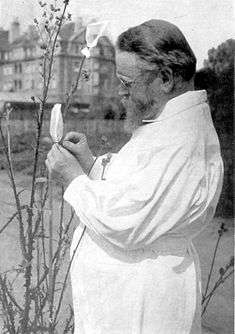Carl Correns
Carl Erich Correns (19 September 1864 [2] – 14 February 1933) was a German botanist and geneticist, who is notable primarily for his independent discovery of the principles of heredity, which he achieved simultaneously but independently of the botanist Hugo de Vries and for his rediscovery of Gregor Mendel's earlier paper on that subject.
Carl Erich Correns | |
|---|---|
 Carl Correns in the 1910s | |
| Born | 19 September 1864 [1] Munich, Germany |
| Died | 14 February 1933 (aged 68) Berlin, Germany |
| Nationality | German |
| Scientific career | |
| Institutions | Kaiser Wilhelm Institute for Biology |
Correns was a student of Karl Nägeli, a renowned botanist with whom Mendel corresponded about his work with peas, and who subsequently engaged in a long exchange of letters concerning reproducibility of the results in another species (Hieracium). Because of the special properties of Hieracium, those experiments failed and Mendel dropped his studies on the subject.
Early life and education
Carl Correns was born September 1864 in Munich. Orphaned at an early age, he was raised by an aunt in Switzerland. He entered the University of Munich in 1885. While there, he was encouraged to study botany by Karl Nägeli. After completing his thesis, Correns became a tutor at the University of Tübingen and in 1913 he became the first director of the newly founded Kaiser Wilhelm Institute for Biology in Berlin-Dahlem. He married a niece of Karl Nägeli, Elisabeth Widmer.
Key experiments and findings

Carl Correns conducted much of the foundational work for the field of genetics at the turn of the 20th century. He rediscovered and independently verified the work of Mendel in a separate model organism. He also discovered cytoplasmic inheritance, an important extension of Mendel's theories, which demonstrated the existence of extra-chromosomal factors on phenotype. Some of his unpublished work and most of his lab books were destroyed in the Berlin bombings of 1945.
Rediscovery of Mendel
In 1892, while at the University of Tübingen, Correns began to experiment with trait inheritance in plants. Correns published his first paper on 25 January 1900, which cited both Charles Darwin and Mendel, recognising the relevance of genetics to Darwin's ideas. In Correns' paper, "G. Mendel's Law Concerning the Behavior of the Progeny of Racial Hybrids", he restated Mendel's results as the' law of segregation' and introduced a new 'law of independent assortment'.[3][4] [5] [6][7][8][9][10]
Cytoplasmic inheritance
After rediscovering Mendel's laws of heredity, which can be explained with chromosomal inheritance, he undertook experiments with the four o'clock plant Mirabilis jalapa to investigate apparent counterexamples to Mendel's laws in the heredity of variegated (green and white mottled) leaf color. Correns found that, while Mendelian traits behave independently of the sex of the source parent, leaf color depended greatly on which parent had which trait. For instance, pollinating an ovule from a white branch with pollen from another white area resulted in white progeny, the predicted result for a recessive gene. Green pollen used on a green stigma resulted in all green progeny, the expected result for a dominant gene. However, if green pollen fertilized a white stigma, the progeny were white, but if the sexes of the donors were reversed (white pollen on a green stigma), the progeny were green.
This non-mendelian inheritance pattern was later traced to a gene named iojap which codes for a small protein required for proper assembly of the chloroplast ribosome. Even though iojap assorts according to Mendel's rules, if the mother is homozygous recessive, then the protein is not produced, the chloroplast ribosomes fail to form, and the plasmid becomes non-functional because the ribosomes cannot be imported into the organelle. The progeny could have functional copies of iojap, but since the chloroplasts come exclusively from the mother in most angiosperms, they would have been inactivated in the previous generation, and so will give white plants. Conversely, if a white father is paired with a green mother with functional chloroplasts, the progeny will only inherit functional chloroplasts, and will thus be green. In his 1909 paper, he established variegated leaf color as the first conclusive example of cytoplasmic inheritance.
References
- "Carl Erich Correns: was Born 19 Sep 1864". TODAY IN SCIENCE HISTORY. 19 September 2017. Retrieved 24 August 2017.
- "Carl Erich Correns: Date of Birth". TODAY IN SCIENCE HISTORY. 19 September 2017. Retrieved 24 August 2017.
- Correns, Carl. (1900). "G. Mendel's Regel über das Verhalten der Nachkommenschaft der Rassenbastarde". Berichte der Deutschen Botanischen Gesellschaft. 18: 158–168.
- Piternick, Leonie Kellen (1950). "G. Mendel's Law Concerning the Behavior of Progeny of Varietal Hybrids (An English translation)" (PDF). Genetics. 35 (5 2): 33–41. PMID 14773780.
- Stern, Curt and Eva Sherwood (1966). The Origin of Genetics: A Mendel Source Book. pp. 119–132. ISBN 978-0716706557.
- R Hagemann (2000). "Erwin Baur or Carl Correns: who really created the theory of plastid inheritance?". J. Hered. 91 (6): 435–40. doi:10.1093/jhered/91.6.435. PMID 11218080.
- Rheinberger, H J (2000). "[Carl Correns' experiments with Pisum, 1896–1899.]". History and Philosophy of the Life Sciences. 22 (2): 187–218. PMID 11488142.
- Rheinberger, H J (December 2000). "Mendelian inheritance in Germany between 1900 and 1910. The case of Carl Correns (1864–1933)". Comptes Rendus de l'Académie des Sciences, Série III. 323 (12): 1089–96. doi:10.1016/s0764-4469(00)01267-1. PMID 11147095.
- Corcos, A F; Monaghan F V (1987). "Correns, an independent discoverer of Mendelism? I. An historical/critical note". J. Hered. 78 (5): 330. doi:10.1093/oxfordjournals.jhered.a110399. PMID 3316376.
- Saha, M S (November 1981). "The Carl Correns papers". The Mendel Newsletter; Archival Resources for the History of Genetics & Allied Sciences. 21: 1–6. PMID 11615874.
- IPNI. Correns.
External links
| Wikimedia Commons has media related to Carl Correns. |